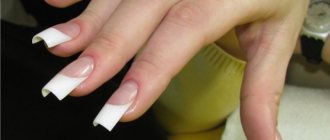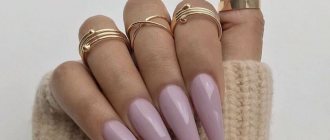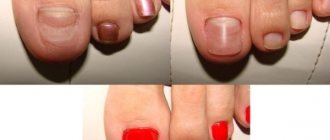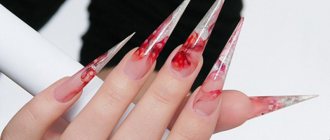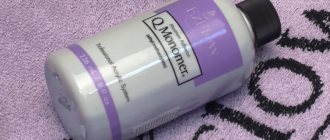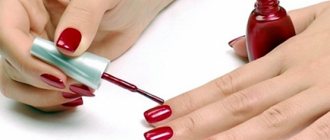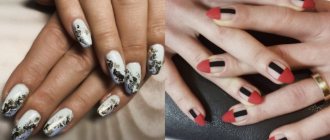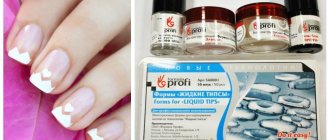Features of the method
With the help of artificial lengthening of the nail plates, almost any external defects are corrected. Usually, forms or tips are used for nail extensions. The latter of them are becoming less and less relevant, as they do not look very natural.
The plates on the forms are enlarged using special devices that act as a substrate for future nails. This product is covered with gel or acrylic, making it easy to extend the edge of the plate. To make it convenient to create the length, the forms have graph paper. A distinctive feature of the technique is that after the varnish has hardened, the structures are removed, leaving the ends free.
More detailed instructions for extensions
First stage
- After disinfecting the palms and fingers with an antiseptic, we treat the nail plates.
- Use a wooden stick to push back the cuticle. It is advisable to trim off the excess using special nippers or sharpened nail scissors.
- Carefully file the nails, leaving approximately 1-5 mm. Use an orange stick to remove dirt under your nails.
- The top glossy layer is removed with a buff and unevenness is removed. Use a brush or brush to shake off the dust.
- We degrease the nail plate using a special product. At home, you can use alcohol to soak a napkin.
- A primer is applied, it ensures adhesion of the material to the nail plate and protects against microbes.
Second phase
After the nails are processed, we select the upper forms of a suitable size, one by one applying them to the nail plate.
The blank should be slightly smaller than the nail plate. The free space will be filled with excess gel.
- The nail is covered with a thin base layer of gel. It should not be dried out.
- The inside of the workpiece is carefully filled with a denser layer of material in the area of the free edge, which should be dried after application (20 seconds). The gel is then applied to the area intended to adhere to the nail plate.
- The procedure can be simplified. A thin layer of gel covers the part of the plate that comes into contact with the nails. The free edge of the workpiece is compacted more tightly (0.5-1mm). At this stage of modeling, you can also determine the approximate desired length of the nail.
- The gel-filled blank is carefully pressed against the nail. There is no need to put pressure on the plate. Turning your palm over, you need to see how the gel lays down; its excess is removed with a pusher.
- Fingers with applied tips are placed under a UV lamp for about five minutes and wait for the material to polymerize. Manufacturers indicate on the packaging how long it takes for the material to harden.
- Once the gel has hardened, the top molds are carefully removed. We wipe the tip and put it back in the box. The nail is degreased. The free edge is processed with a file, which is given a neat appearance.
- To consolidate the result, this extension technology provides the possibility of applying a finishing coating. It is advisable to do this, but there is no particular need. This layer is polymerized for about two minutes.
- Degrease the nail plate. Lubricate the cuticle with special oil.
Advantages and disadvantages
The extension procedure using forms has both advantages and disadvantages. Most masters and clients prefer this method due to the following advantages:
- Unlike tips, it does not cover the main part of the nail, due to which most of the natural plate has access to oxygen.
- Artificial nails made on substrates are thinner and look natural.
- After mastering the method, you can perform it at home.
- Allows you to make any nail shape, as well as choose your own length
- Strengthens brittle tips on short nails.
- You can perform the correction procedure without the need to completely remove the extended layer.
- The cured gel polish beautifully complements the natural nail plate without a noticeable transition.
Among the disadvantages of modeling using forms, they note that the procedures are quite complex compared to using tips. Also, low-quality materials and poor application technique can significantly slow down the growth of nails and damage their structure. These shortcomings usually go away with the experience gained. If the rules for extensions on forms are strictly followed, there are no negative aspects.
What's better?
It is impossible to say unequivocally which of the two materials is better, since each option has its own advantages. For example, acrylic dries faster, which affects the time of the entire work process. In addition, it is easier to lay it out in a thin layer, making it look more natural.
It should be noted that acrylic has an attractive price, it is economical to work with and is characterized by high strength.
When applying gel nail extensions, you can afford various fantasy solutions. For example, even a French coat can be made with colored materials of this type. However, if you don’t have a special lamp at home, you should try acrylic modeling.
The difference between the upper forms and the usual ones
The usual forms mean tips, liquid tips and disposable templates for extensions.
- The upper ones are reusable. After polymerization, the material separates effortlessly and leaves no marks on the workpiece, so it can be used until it loses its bending. Approximate service life – 2 years;
- The upper forms do not polymerize along with the coating, but are removed immediately after the material has hardened;
- The technique of working with forms allows you to save material and create nails that are close in thickness to natural ones;
- The extension procedure is halved and takes from 1 to 1.5 hours including decoration;
- The end result requires almost no modification. After polymerization, you only need to remove excess and polish the resulting nail;
- Unlike liquid tips, where the material is applied only to 2/3 of the natural nail, top forms involve laying gel over the entire nail plate;
- There is no need to add material after removal.
Required tools and materials
In order to make beautiful and safe extensions, you need to acquire special equipment and tools.
Among the most important tools, it is worth highlighting these products and materials:
- antiseptic solution;
- cuticle remover;
- nail scissors;
- files with different abrasiveness or cutters for hardware manicure;
- cuticle tweezers or a special orange stick;
- quick nail polish remover;
- nail dust brush;
- a dehydrator that removes the sticky layer from gel coatings;
- suitable forms for extensions;
- a primer that bonds the gel layers and the edge of the natural plate;
- base coat;
- gel brushes;
- modeling varnish;
- colored coating and items for decoration;
- finishing gel;
- UF lamp;
- care oil for cuticle treatment.
To make the extension procedure easy and successful, it is important to choose high-quality tools and materials.
Tools for nail extensions on forms / @nailcity
Which is better: gel or acrylic?
Advantages of gel extensions:
- Natural look.
- No smell.
- No possibility of fungal development.
- Multifunctionality (decor, French manicure, modeling).
- Able to attach very well to the nail plate.
- Significant strength and elasticity, so nails are not subject to cracks and do not break even under strong mechanical stress.
- Easy correction (new extensions, silk strips).
- Protecting the surface of the natural nail from the harmful effects of the environment.
Disadvantages of gel extensions:
- Does not tolerate sudden changes in temperature.
- The removal process takes quite a long time.
Advantages of acrylic extensions:
- strength,
- hygiene,
- flexibility,
- ease of care,
- resistance to chemicals,
- easy correction and removal (need to be kept in a special solution that does not contain acetone),
- various designs.
Disadvantages:
- smell;
- the coating does not allow air to pass through to the nails, which is why their condition and appearance deteriorate after removal;
- less natural appearance than gel ones.
The acrylic mass, prepared from acrylic powder and a special solution, hardens very quickly in air, so experts advise having acrylic extensions done by an experienced professional. Acrylic nail extensions can be done on tips and nails.
The choice of material should be based on an analysis of the advantages and disadvantages of each material, as well as the client’s requirements for the final result.
Shape selection
First of all, plate extension products are divided into disposable and reusable. Each of the masters chooses the most convenient option depending on the number of clients and personal preference.
Disposable templates have a very soft base, as they are made of paper or thin plastic. Due to their flexibility, these products can be easily adjusted to different shapes. At the same time, many note some difficulty in the work at the very moment of extension. If you fix the paper template incorrectly or insufficiently, it can wrinkle and deform the artificial layer.
@assorti.com.ua
@nailmagazin_05_
Reusable molds can be used an unlimited number of times due to their durable metal or thick plastic composition. Such products are not subject to mechanical stress and are securely fastened. They must be stored in sterile containers and processed after each procedure.
@nails_way_ukraine
Forms for extensions are also divided according to the method of fastening the structure - from below or from above. Bottom templates are the standard option when the product is used as a guide attached under the natural nail.
@nailmagazin_05_
The upper structures are ready-made plastic forms with different sizes. They are filled with polygel and placed on top of the nail, and after hardening they are easily removed.
@fifachka.shop
All forms vary in size from the smallest to three centimeters. They come in the form of halves or whole. Half templates are attached to long nails, while full ones are best used on short ones.
Shapes and colors vary. Transparent products are considered a classic option. Many people like colored designs, but they are a little more difficult to work with due to their density.
@mila_nails_shop_ua_
How to choose?
When buying top forms for nail extensions, you should pay attention to a number of nuances. For example, the inside of templates is very important. It should not have visible defects; a quality product will leave the desired gloss on new nails.
Typically, such frames are enough for 40-50 extensions. It is better to buy a frame with markings, especially for novice craftsmen.
When choosing the required option, you should take a closer look at the shape of the templates, which may differ. Sometimes it is more curved, sometimes the difference may be in the height of the arch. It is better to take the option in which the manicure hatchet can fit in the space between the form itself and the nail plate.
It is recommended to purchase sets with a large number of elements - this will allow you to select the required sizes as accurately as possible.
Depending on the type of sculpting product, when applying extensions to silicone top molds, you may need gel products, as well as base, top and acrylic. In addition to them, you need to prepare the templates themselves, primer material for coupling (primer), cuticle oil, glossy coating, dispersion layer remover, brushes, files, orange stick and dehydrator.
Preparation
Before actual extensions, it is necessary to properly prepare your nails for the procedure.
To do this, the following step-by-step processing is performed:
- Apply antiseptic to your fingers and nails.
- Perform a hygienic manicure by removing old polish and moving or removing the cuticle and pterygium.
- File the ends of your nails. It is important to leave a free edge of at least 0.5 mm in length, otherwise it will be impossible to pry or fix the lower form. Using a soft nail file, treat the surface of the plates to remove shine. Remove nail dust with a brush.
- Use the dehydrator solution over the entire surface of your nails.
- Apply primer.
- Cover the plates with a thin layer of base gel and dry them under a lamp for about three minutes.
Preparatory stage of extensions on forms / LadyWow
Step-by-step instruction
After all the preparatory procedures, you can proceed to the stages of artificial turf modeling. The extension must be done first on the four fingers of one hand, then on the other, and only then on the thumbs. This is necessary so that the coating does not run off during application. Beginners usually work on each finger separately.
Depending on the type of templates, the process may vary slightly.
For gel extensions using lower structures, the technique will look like this:
- Place the form under the free edge of the nail. If the product is hard, then this will be quite easy to do. However, when using disposable paper templates, adjust the window depending on the size of the arch under the nail. Make sure there are no gaps or creases. Having fixed the shape, make sure that it has a smooth bend without a springboard or, conversely, a steep slope. If the shapes are very soft, you can glue the two structures together.
- Apply a thin layer of gel to the base of the nail in the cuticle area, thickening it as you approach the transition zone from the natural nail to the form. The stress zone (in the transition area) needs to be compacted especially well. Next, cover the future end of the artificial nail with a thin layer again.
- Dry your nails under the lamp for 2-3 minutes.
- Remove the sticky layer from the hardened gel and carefully remove the mold.
- Sand the surface and adjust the free edge of the plate.
- Apply camo or any of the colored gels in two or three layers, curing each application under a lamp. Create a design if necessary. When finished, coat your nails with topcoat and keep it in a UF lamp for a longer time.
- Remove the sticky layer and lubricate your hands and cuticles with a moisturizing emulsion.
Step-by-step extension technique on forms / LadyWow
When using upper forms, the extension technology will be different:
- Select a template that matches the size of the natural plate.
- Apply a special gel or acrylic to the inside of the product in the area of the free edge and dry in a lamp for 20 seconds.
- Fill in the rest of the template to match the length of your natural nail. Press firmly onto the plate, starting from the cuticle area, and dry in a UV lamp for 30 seconds.
- Remove any gel protruding beyond the mold without changing the position of the product. Dry your nails again, this time for about three minutes.
- With a slight movement, remove the mold structure.
- File and apply a finishing layer or decorative gel.
Nail extensions on top forms / LadyWow
Varieties
Today, two types of upper forms are known. Depending on the cost, they can be either with or without markings to facilitate the work process. The first option is especially convenient for beginners who are getting acquainted with nail extensions using such templates.
The markings on the forms may differ; in some places they are arched stripes, in others they are a grid.
The set has the same arch and length, as well as markings with the indicated dimensions. Based on the marking lines, it is easier to align the length and adjust the edge. There is no need to tediously adjust an identical shape, since it already exists.
The upper forms are classified as reusable types of extension templates. They differ from arched counterparts and liquid tips.
Photo examples
When done correctly, extensions on forms can create a neat and beautiful manicure. Smooth, long nails are suitable for any decoration and allow you to realize the most interesting design ideas.
@beauty.studio.chkalovsk
@dashkevich348
@fenix_iva
@just.nails.ekb
@pariyanails
@pariyanails
@pariyanails
@saida_nails_shik
@actualnails
@actualnails
@alekhina_daria
@bebeautymood
@black_queen.bakhmut
@cherie_annette_nails
@ekaterina_nails_novotroitskoye
@nailsjustnailss
@nazirova_anna
@shalneva_nails
@tvoi_nogtiki

